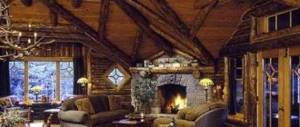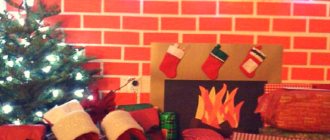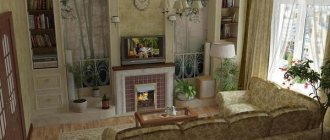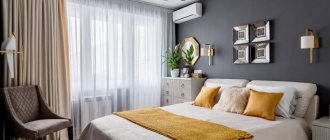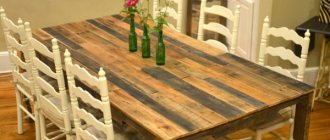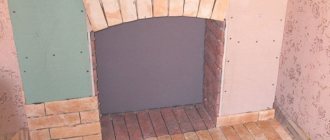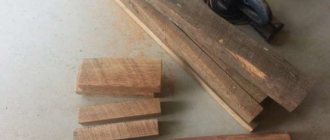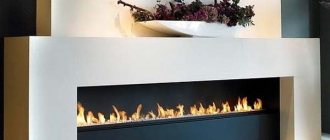Wood-burning brick fireplaces are a decoration for any country house or cottage.
Do you admire photos of fireplaces, but can’t decide to install one for yourself? Ordering work from a specialist mason is an expensive pleasure, so many consider it an unnecessary luxury.
However, there is another way to acquire this magnificent piece of furniture - to build it yourself.
Do you think it's too difficult? Read our guide and you will understand that building a brick fireplace yourself is accessible to almost everyone.
Brick fireplaces are simply stoves with an open firebox, so understanding this will make it easier for you to understand exactly how efficient wood-burning fireplaces are built.
And at your dacha, you can easily make an outdoor grill with your own hands, such as in the video below, which is used not only for cooking, but which is also a real decoration for the veranda or gazebo.
Video:
All construction can be divided into several stages:
- preparatory (understand the features of construction, choose a model);
- selection of materials;
- choosing a location on the territory of your country house;
- construction of a fireplace;
- creating a chimney;
- cladding, decoration.
You can use brick to make an excellent, practical fireplace for a summer house, which will not only decorate the room, but also heat it.
The heat that this type of stove emits is a way to maintain a comfortable temperature in the house and save on electricity.
Preparing to build a fireplace
Before you start building a stove, you need to understand how it works.
Today there are a huge number of types of fireplaces, they can be wall-mounted, island and built-in.
You can make it with your own hands the way you want. But the basic elements that make up this type of stove are almost always the same.
Fireplace design
Let's figure out what the structure of a classic fireplace is.
No matter what it looks like on the outside, inside they always have the following elements (you can see the vertical section in the photo below):
- firebox (the space where wood is burned);
- fuel basket - a metal basket on which firewood is stacked;
- Under the fuel basket there is a platform called the fuel tank; it has the shape of a rectangle or trapezoid, tapering towards the rear wall. Sometimes a cavity is created in the hearth of the fireplace in which food can be prepared;
- above the fuel basket there is a fireplace mouth - a narrow place in the pipe above the firebox into which smoke rushes;
- in front of the mouth (the front of the fireplace) there is a small lintel or ceiling;
- behind the mouth (back wall) there is a so-called “tooth”, a gas threshold;
- above there is a smoke collector (smoke bag), from where the smoke enters the chimney;
- there is a damper on the front wall that regulates the smoke flow;
- Under the firebox there is an ash pan, which must be cleaned of ash from time to time.
We have figured out the approximate design of fireplaces, now we need to decide what exactly ours will be, and we will also need a diagram.
If you are not ready to design your stove completely yourself, then you can find photos of finished projects that can be slightly modernized to make your fireplace unique.
Required materials and tools
In order to make a wood-burning fireplace, you will need several basic raw materials, for example, brick, which is the most common source. Today, there are no standard or universal models of fireplaces; everything directly depends on the size of the room, the required power and the intended type of fuel.
So, for a wood-burning fireplace you will need:
- Brick (it’s better to take fireclay, fireproof, but ordinary red is also quite suitable).
- Solution.
- Clay + Sand.
- Metal door.
- Sheet metal for ducts and chimney.
The construction of such a structure will allow you to significantly save on purchases and provide high-quality heating of the room for a long time.
Choosing a fireplace model
A brick fireplace stove can be closed or open, wall-mounted, corner or located in the center of the room.
You can choose a suitable model in the photo below, and you will also need a ready-made diagram or drawing if you are not ready to draw it up yourself.
Photo:
You can see drawings of beautiful brick fireplaces below, and there is also a video about how they are built at the dacha with your own hands.
Photo:
A closed fireplace is built on the base of a cast-iron firebox, which is simply lined with brick.
The front wall of the firebox is made of heat-resistant glass.
Laying a fireplace from open brick is carried out according to a different principle and includes making a firebox from stone with your own hands, the diagram of which is below.
Whatever model you choose, the fireplace will always be the center of any room. Therefore, it is important that it fits harmoniously into the interior design and is made in the same style.
Much depends on the size of the room; the smaller the room, the smaller the fireplace.
See the photo below to see what different types of stoves look like in the interior.
Photo:
Brick fireplaces for home
The difference between brick fireplaces for the home
may lie in their size. Indeed, for those who design such a heating system at the stage of building a cottage, it can become fundamental. The interior decoration is built around such a fireplace, windows and doorways are designed, and furniture is placed. In order to understand how different the options can be, you can look at the photographs in our article today.
The ancestors of all the various brick fireplaces, photo
which you can see above, became stone hearths that were built to heat homes in the countries of the western and northern parts of the European continent.
It was this device with a wide firebox that made it possible to effectively heat the space closest to the fire, and the chimney, which often ran not only in the room on the first floor, but also on the next, made it possible to also use hot air for heating before it left the house through the chimney. Over time, when the production of bricks was established, they became the favorite material for laying stoves. After all, their size was standard, which means that the stove maker’s work was greatly facilitated; you just had to understand the sequence of laying out the rows in order to get an excellent result over and over again. Since our goal today is to review the most popular models and ideas for solving such an element in the interior, we will not touch on the steps of laying a brick fireplace with our own hands
. This process is not only labor-intensive, but also very responsible. We are not talking about a heating device that stands on the street or a summer terrace and is used for preparing delicious dishes, but about a heating device that is located indoors. If the chimney is not installed correctly and the correct geometry of all internal chambers is not observed, the draft may be disrupted, and then carbon monoxide may enter the living space. This is not only unpleasant, but also dangerous to health and life, so it is better to contact specialists who have already installed such systems for installation and masonry.
In the meantime, we can admire examples of a fireplace made of brick with our own hands, photo
ready-made examples of which you see above, and learn a little more about the material itself.
Traditionally, two types are used for stoves - red and refractory. They differ in their properties and also differ significantly in price. The ideal refractory (aka fireclay) brick for laying is quite expensive and is unlikely to be suitable for a budget project. On the other hand, red brick will not be able to withstand high temperatures in the combustion chamber for a long time, especially if it is closed. Therefore, most often in brick fireplaces for wood-burning houses,
a compromise option is used, by assembling only the chamber itself for burning solid fuel from fireclay bricks, and all other functional parts are laid out in red.
a brick fireplace project
that is suitable for yourself , you must understand not only how it will fit into your interior and how much its installation will cost, but also whether it will cope with the functions that you assign to it. For example, an important indicator of the finished structure will be heat transfer, the ability to warm up a room of a given volume. On the contrary, you should not make a very large fireplace in a small room; it will be inconvenient to use, and it will take quite a lot of fuel to light it. If you want to make a useful device, providing it with functions, then in addition to the hearth itself, you will also need a convenient design geometry with shelves, a table top, and the like.
Fireplace stove location
The question of location is the most important one at the preparatory stage.
Wood-burning fireplaces are installed on a foundation, and then moving them to another place is impossible.
Basic rules for placing a fireplace in the interior:
- A fireplace is the main element of any interior. If it is installed in the right place, then other interior items no longer attract so much attention;
- Usually it is installed in the living room, less often in the dining room or bedroom. If a fireplace is made in the bedroom, then, as a rule, a small corner fireplace made of brick is chosen;
- Sofas and armchairs are arranged in a semicircle around the hearth, which is never installed in the passage parts of the room;
- The stove is not placed in protruding parts of the walls; on the contrary, it is better to place it in an arch or in the corner of the room, if possible;
- It is better not to place a fireplace near the entrances and exits of the room - the presence of doors next to it makes the interior less cozy;
- It is better not to build a fireplace near the outer wall of the house; due to the temperature difference in the house and outside, too much condensation will collect inside the chimney.
Kinds
In general, wood-burning fireplaces and stoves are classified depending on the material from which the body is made:
- Brick.
- Cast iron.
- Steel.
Each model is characterized by its own characteristics and is offered for specific premises.
For example, if there is a need to heat a large room at once, it is best to opt for cast iron models with different contours:
- Dual-circuit.
- Single-circuit.
The advantage of this type of fireplace is the fact that they can serve as a cooking stove.
The brick model must be purchased and installed, and perhaps laid out independently during the construction of the house. This is due to the fact that a special reinforced foundation is not required.
Steel models are more versatile and simpler in design and do not require additional buildings.
One of the most interesting recent models is considered to be the Kuznetsov fireplace stove, which is based on an unconventional fuel combustion system, namely, the material burns in a special hood, which then optimizes it into heat.
Dividing wood stoves according to their structural characteristics, we can distinguish:
- Floor type.
- Fireplace with open hearth.
- Brick stoves with a closed firebox.
- Small-sized wood-burning fireplace.
- Wood-burning type with water circuit.
Each of the types described above has its own configuration and characteristics of combustion and operation, so the consumer needs to pay special attention to these characteristics and choose the fireplace most suitable for solving certain problems, based on the capabilities of the room.
Selection of required materials
The fireplace body (its main part) is made of solid clay brick or fireclay.
A high-quality, properly fired brick should be orange-red and uniform in color.
Another way to check the quality of the material is to hit it with a metal hammer. The sound should be clear, not dull, and not ringing.
If the brick has an uneven color, then this is a sign of errors in the production technology; you do not need such a brick.
You should not experiment with the type of material.
Only the kind of brick described above will suit you; silicate and hollow ones will not work, since the first cannot withstand high temperatures, and the second has poor heat transfer.
Wood-burning fireplaces must have a chimney, which is made of special stove bricks, and the outer part of the pipe, which goes outside, is made of ceramic.
This is done because stove bricks tend to deteriorate from exposure to weather conditions and precipitation. The chimney diagram is visible below.
Do-it-yourself mortar for laying bricks is made from clay.
The clay is soaked in advance for two to three days, giving it the opportunity to soak in water. After this, it is wiped through a mesh with a mesh of 3-5 mm and mixed with sand and water.
The composition of the solution is approximately the following: 4 parts clay, 8 parts sand and 1 part water. You can also add a little cement, no more than 1 part.
The final solution should have the consistency of thick sour cream.
The clay for the mixture will need to be oily, which means that initially the percentage of sand in it should be very low (no more than 3%).
The sand for the solution is taken clean, medium size, without large grains.
It is not recommended to add cement to the mortar that will be used directly when laying the firebox.
High temperatures require that all materials be thermally stable. Therefore, it is better not to use cement, but in order to make the mixture even more heat-resistant, the sand is replaced with fireclay powder.
To clad brick fireplaces, natural stone, ceramic tiles, wood, and plaster are used.
Selecting the material
A brick fireplace for a cottage or home will be reliable and of high quality if the right material is chosen and of good quality. Photos of brick fireplaces will help you choose the right design. So the material must be chosen carefully. Let's immediately determine what a fireplace is and what parts it consists of.
Fireplace design:
| Foundation | Even broken or used bricks are quite suitable for pouring here. You should not use silicate, it absorbs too much moisture and is not suitable. Well, for the base you will need a simple clay material, but only a solid one. For these purposes, they mainly use M100 brick. After installation, you can always do the cladding. Clinker tiles are best suited for this. It can have different relief and will not be difficult to choose for the desired interior. |
| Furnace part | Fireclay material is used for this work. It holds almost any temperature, and you can even use solid fuel when burning without any problems. This is especially true if a brick stove is being built. Many people combine these designs. If there is a fireplace in the country house, then it will perfectly replace the heating source. |
| Frame | The main masonry is made with solid material. It holds heat well and has great heat transfer. For these purposes, M200 brick is most often used. Although if the fireplace itself does not have much weight, then M100 will do. The laying is done in the brick floor and is no different from the laying of walls. As a rule, non-face brick is used for masonry. Although the finishing is done with facing material. After all, it is simply expensive and is not used for rough cladding. Attention: Think about your choice of finish in advance. After all, if it is made of facing material, then it will be necessary to provide for this place in the size of the foundation. |
| Chimney | A brick wall fireplace is made only of bricks. But for the chimney, collapsible structures are mostly used. They can be assembled quite quickly and the price is not high. But the cladding can already be made with facing material. |
| Solution | They don’t think about it that often, but it’s in vain. For the combustion part, a clay solution will be most relevant. After all, it holds any temperature. A cement composition is also suitable for rough plaster. But for cladding you can also use a dry mixture. After all, you can even choose it by color. |
Brick fireplace prices can be quite different. After all, you can use a material whose price varies significantly. But expensive does not mean good, look at the certificates of quality and compliance. A special parameter is the temperature at which the material can be used.
How to choose the right brick
When choosing a brick for a fireplace, you need to be careful. This is not such a simple question and you need to choose quality material.
Fireplace construction technology
At your dacha, you can make an open fireplace with your own hands or a closed one, based on a cast-iron firebox.
You can see the designs of brick fireplaces above, there is also a diagram of the chimney.
First, the foundation is poured. On average, a fireplace stove weighs about a ton, and of course no floor can support it. Therefore, a real stable foundation is made, on which a sheet of roofing material is laid.
This is done because brick is very hygroscopic and easily picks up water, which means it needs to be insulated from moisture.
The order of the bricks is carried out in a checkerboard pattern as follows: take a brick in your left hand, lower it into the water for a couple of seconds, and with your right hand apply the clay-sand mixture, lay the brick and press it on top.
The arrangement of the fireplace begins with the corners, and then the walls are filled. You can see how this is done in the video below.
Video:
Chimney device
The design of the chimney is no less important than the design of the fireplace itself. Without strong draft, a fireplace simply will not be able to function in a house or country house - smoke and soot will enter the rooms.
The construction of fireplaces for a brick house will not be complete without the construction of a chimney. If you are building an outdoor grill in a gazebo, then you will also need a chimney.
Its basis is a vertical channel made of heat-resistant material through which smoke and combustion products will escape.
As the main channel, you can use a ceramic pipe, which is an excellent heat-resistant material.
It is sheathed on top with sheets of mineral wool, and then the brick is laid.
Do not forget that every chimney needs systematic cleaning.
Twice a year it is necessary to carry out diagnostics, even if everything is in order, because soot mixed with condensate settles on the internal parts of the chimney.
Criterias of choice
Before you rush to the store to make a purchase, you should evaluate all the criteria by which you will need to choose this or that model; there are not many of them, so the calculations will not be difficult:
- Dimensions of the room.
- Financial opportunities.
- Design.
- Power specifications.
- Functional features.
- Nuances associated with installation and launch.
- Type of intended fuel (firewood, coal, bags, briquettes).
But, even with these parameters, the most important thing when purchasing remains the duration of combustion, the degree of heat transfer and the time of maximum heating.
Heating time, depending on the model of kindling material used, can vary from 3 hours to 10 hours.
